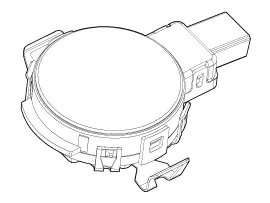Hyundai Genesis (DH): Auto Lighting Control System / Description and Operation
Hyundai Genesis (DH) 2013-2016 Service Manual / Body Electrical System / Auto Lighting Control System / Description and Operation
| Description |
| Integrated Rain Sensor |
Integrated rain sensor (A) controls three systems: front wiper, auto-light, and central air conditioner.
| 1. |
Wiper Control System
When "AUTO" switch signal is received from the multi-function
switch on the right, the integrated rain sensor detects the amount of
rainfall. The sensor is installed inside the upper part of the front
window for wiper motor control.
This system automatically controls the operation duration and
speed of the wiper depending on the measured amount of rainfall even if
the driver does not operate the wiper switch. |
| 2. |
Auto Light Control System
When "AUTO" signal is received from the multi-function switch
on the left, the integrated rain sensor installed on the front window
detects the brightness of the light and controls the operation of the
head lamp and screen brightness of the internal multimedia.
This system automatically controls the brightness of the head
lamp and the internal multimedia screen depending on the measured
brightness even if the driver does not operate the lamp switch. |
| 3. |
Central Air Conditioning System
When "AUTO" signal is received from the central air
conditioner switch, the integrated rain sensor detects the amount of
sunlight depending on the direction of the sunlight.
This system automatically controls the cooling system
depending on the measured amount of sunlight even if the driver does not
operate the air conditioner switch. |

| Functions and Operating Principles |
Basic Principle
| 1. |
Detecting the amount of rainfall
The light (beam) emitted from light emitting diodes (LED) is
totally reflected on the external surface of the windshield and comes
back to the photo diodes. When there is water on the external surface of
the windshield, the light is optically separated and reflected
partially and the remaining brightness is measured by the photo diodes.
Water remaining on the windshield results in the light being not totally
reflected. The loss of brightness due to this indicates how much the
glass surface is wet. |
| 2. |
Detecting light
Brightness of light is measured by the diodes using the
infrared light. The brightness of the outside of the vehicle is measured
in two directions: (a) the upper direction and (b) the front direction.
The measured amount of light is used to determine whether it is day or
night. |
| 3. |
Detecting the amount of sunlight
The system measures the amount of sunlight from the left and
right sides and operates the air conditioner on the driver side or the
passenger side. |
Integrated rain sensor is composed of 2 LEDs and 2 photo
diodes to detect rainfall, 2 photo diodes to detect light, 1 photo diode
to detect the amount of sunlight, and bracket. |
Operation Control
| 1. |
When "AUTO" signal is received from the multi-function switch
on the right, the integrated rain sensor detects the rainfall and
controls the wiper motor. |
| 2. |
When "AUTO" signal is received from the multi-function switch
on the left, the integrated rain sensor detects the brightness and
controls the head lamp and internal multimedia brightness. |
| 3. |
When "AUTO" signal is received from the central air
conditioner switch, the integrated rain sensor detects the amount of
sunlight and controls the air conditioning system. |
Interference
Integrated rain sensor might malfunction due to the interferences listed below.
| 1. |
Dust on the measuring surface and other surfaces on the
light path (surface of light emitting diodes and photo diodes, fiber
optics, bracket, and glass surface of windshield joint area) weakens the
received light. |
| 2. |
Movement of windshield and bracket |
| 3. |
Movement of bracket due to vibration |
| 4. |
Damaged wiper blade |
| 5. |
Damaged head lamp |
| 6. |
Damaged multimedia device |
| 7. |
Damaged air conditioning system |
When the integrated rain sensor does not operate or malfunctions, the driver should operate the wiper switch manually.
When the integrated rain sensor does not operate or malfunctions, the driver should operate the head lamp switch manually.
When the integrated rain sensor does not operate or malfunctions, the driver should operate the air conditioner switch manually. |
Automatic Operation
| 1. |
Operational status of rain sensor
|
| 2. |
Operational status of light sensor
|
| 3. |
Operational status of solar load sensor
|
Safety Function High
| 1. |
When there is ice or foreign matter in the detecting area,
integrated rain sensor cannot recognize the condition for operation
correctly. |
Detecting Special Conditions
| 1. |
Rain sensor
|
| 2. |
Light sensor
|
Circuit Diagram
Components and Components Location 1. Horizontal light sensor2. Vertical light sensor3. Solar load sensor4. Rain sensor - left5. Rain sensor - right
Other information:
Hyundai Genesis (DH) 2013-2016 Service Manual: Blind Spot Detection Indicator Components and Components Location
C
Hyundai Genesis (DH) 2013-2016 Service Manual: Climate Control Air Filter Repair procedures
Replacement 1. Remove both stoppers (B) by turning them from the glove box (A). 2. Disconnect the air damper (A) from the glove box (B). 3. Remove the filter cover (A) by pressing the knob. 4. Replace the air filter (A) with a new one according to the direction of air filter.
Categories
- Manuals Home
- Hyundai Genesis Owners Manual
- Hyundai Genesis Service Manual
- Starter Repair procedures
- Emission Control System
- Front Door
- New on site
- Most important about car
Copyright В© 2026 www.hgenesisdh.com - 0.0262

